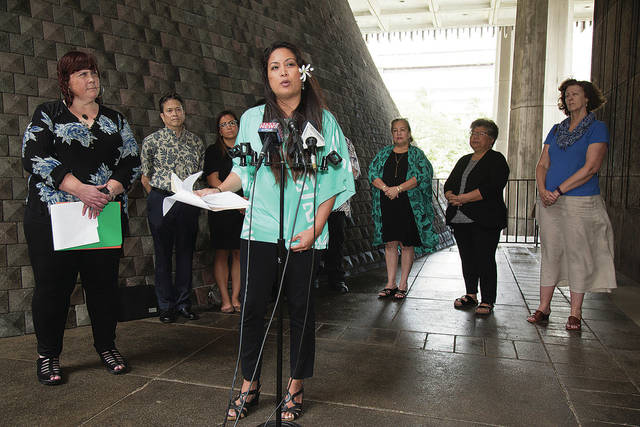Number of homeless drops on Oahu

KAT WADE / SPECIAL TO THE HONOLULU STAR-ADVERTISER
Some homeless people gathered their belongings Monday after the second sweep of the day along Cooke Street, shortly following the announcement of the Point in Time Count of the homeless for 2018 in the rotunda of the state Capitol.

KAT WADE / SPECIAL TO THE HONOLULU STAR-ADVERTISER
Brandee Menino, chairwoman of Bridging the Gap, announced results from the Point in Time Count that took place Jan. 22.


A one-day census of Oahu’s homeless population decreased for the first time in nine years and resulted in the statewide Point in Time Count decreasing for the second year in a row.
Statewide, the number of homeless individuals in 2018 dropped almost 10 percent to 6,530. That’s in comparison with 2017, when Hawaii’s statewide homeless count fell about 9 percent for a total homeless population of 7,220 people.
This year’s 690-person drop, which was fueled by a 9 percent decrease in unsheltered homelessness, was celebrated by stakeholders at a Partners in Care and Bridging the Gap news conference held Monday at the state Capitol. The results were greatly improved from last year’s 2017 nationwide Point in Time Count, which showed Hawaii still had the nation’s highest per capita rate of homelessness.
Bridging the Gap Chairwoman Brandee Menino said, “Efforts to end homelessness are far from over, but the data indicates that we are on the right track to functional zero.”
In homeless provider circles, “functional zero” isn’t as robust as it sounds. It accepts new people will fall into homelessness but assumes the rate is effectively zero if they can be identified and rehoused quickly.
The target was touted during the release of the Point in Time Count, which is limited to a census of homelessness during a one-day period in January. This year a team of about 600 surveyors statewide asked homeless people the same question: “Where did you sleep this past Monday, Jan. 22?”
Don't miss out on what's happening!
Stay in touch with breaking news, as it happens, conveniently in your email inbox. It's FREE!
According to their answers, Oahu’s homeless population in 2018 fell just over 9 percent to 4,495, a 464-person drop from 2017. While the overall count of Oahu’s unsheltered population fell, it rose along the Waianae Coast, in Ewa and in East Honolulu, including Waikiki.
Kauai saw its homeless population achieve a year-over-year decline of nearly 29 percent to 293 people, a 119-person drop. Maui County had a nearly 3 percent decrease to 873 people, a decline of 23 individuals. Hawaii island’s homeless population dropped nearly 9 percent to 869, an 84-person downturn.
Stakeholders at the news conference said these results indicate that their policies and programs are working. However, the decreases aren’t necessarily advantageous from a funding perspective. Numbers are used to apply for grants and help determine how much federal funding Hawaii gets for homeless programs and housing.
Despite its importance, the count isn’t an exact science. The American Civil Liberties Union and several volunteer counters said city sweeps might have skewed this year’s Oahu numbers. According to ACLU records, sweeps were conducted Dec. 26, Dec. 27, Jan. 11 and Jan. 22, this year’s Point in Time date.
Alani Apio, a volunteer counter, said these sweeps occurred in the urban corridor, including Kakaako, downtown, Waikiki and Kaneohe, in areas known for their homeless concentrations. Apio said sweeps weren’t conducted during last year’s count, when Oahu was the only island to post an increase in homelessness.
Kimo Carvalho, community relations director for the Institute for Human Services, said, “We noticed because of sweeps that many homeless individuals were upset or angry and didn’t want to engage with us. It’s concerning because when a person refuses to participate, they don’t get counted.”
Alvaro Sanchez, a homeless man living in Kakaako, participated in this year’s count. But Sanchez said sweeps force people to spread out, and “everyone goes into hiding in little holes.”
Marc Alexander, executive director of the Mayor’s Office of Housing, said enforcements, the city’s word for sweeps, have “minimal impact” since they are “minimized immediately before and during counts.” Alexander said count increases in certain areas, including East Honolulu, Ewa and Waianae, tend to validate the total count.
“The increase in sheltered chronically homeless demonstrate the positive impact of enforcements and outreach in getting the most vulnerable into shelter,” he said.
But Mufi Hannemann, president and CEO of the Hawaii Lodging & Tourism Association, said the overall count doesn’t reflect the reality of what he and other visitor industry members regularly see in Waikiki and other resort areas across the state.
“Homelessness is still a big ongoing concern for us,” Hannemann said.
2018 Point in Time Count: Oahu and Neighbor Island HDX Tables by Honolulu Star-Advertiser on Scribd



